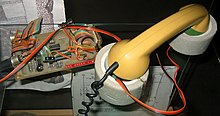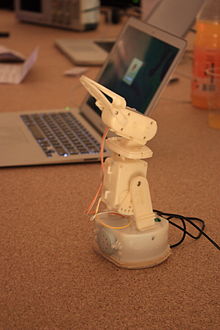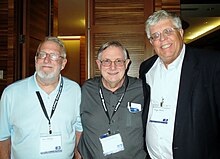Hardware hacker
Hardware hackers are hackers who modify hardware on the one hand in order to gain access to a device or a new functionality that is not intended by the manufacturer. This also includes circumventing a hardware or software restriction. Examples of this are the addition of network capabilities for a number of vending machines and coffee makers and the Playstation hack . On the other hand, they sometimes develop devices themselves, such as the data toilet , a do-it-yourself acoustic coupler kit for a computer to access the network via the telephone line; developed by hackers from the Chaos Computer Club .
Hardware hackers appear as a mutually very different sub-form in every hacker scene. Hacking hardware refers primarily to the area of information and communication technology, but in its original meaning “tinkering / tinkering”, hacking is not limited to information technology areas.
In the context of a playful and creative use of technology of all kinds, they write device drivers and firmware or deal with the physical basics of networks, especially when they use things outside of the specification. A characteristic of a hacker is not the activity itself, but the way it is carried out. As the Jargon File describes, a hacker enjoys the intellectual challenge of creatively pushing boundaries or bypassing them. For this, you often need a very complex and deep knowledge of the (programming) technique and technology used.
overview

Reworking technical devices and using them in a way for which they were not originally intended is part of the essence of hacker culture. In its original use, the term “hacker” refers to tinkerers in the context of a playful self-referential devotion to technology. Wau Holland coined the phrase: "A hacker is someone who tries to find a way to make toast with a coffee machine". In contrast to improvisation , which is used to solve problems that arise, this is often about the experimental, the attempt to explore the limits of what is feasible (based on the example, the experiment is also carried out if a standard toaster is available).
Hardware hackers in the early home computer scene



In the early days, the strongest cultural connection to the hardware hackers was the development of the home computer scene. The journalist Steven Levy describes them in his book "Hackers - Heroes of the Computer Revolution" as a group of technology enthusiasts who were enthusiastic about the idea of a personal computer. Through practical projects and developments, right up to the birth of a completely new industry in Silicon Valley , they decisively advanced the development of the personal computer ( microcomputer , later home computer, now mostly PC ). Part of their legacy was the development of the first personal computers.
The idea that computers should find their place in private households and be freely accessible to everyone was dismissed as absurd by the prevailing industry in the 1970s. Typical of this attitude was the saying of Thomas J. Watson , the former head of IBM , who declared in 1943: "I believe that there is a world market for maybe five computers" . If not to that extent, companies like Texas Instruments , Fairchild , IBM and DEC still basically followed this decree in the 1970s. When asked about the development of a computer for private households by an employee, DEC boss Ken Olsen rejected this proposal in 1977 on the grounds that he could not imagine any private person who would want such a computer. Only the overwhelming sales success of such devices by other companies (partly outside the industry, partly newly founded) should induce the prevailing industry to adopt the idea of the personal computer, develop its own products and bring them to market.
Mainly in the San Francisco area , on the west coast of the United States, hackers had a more farsighted idea of the practical use of a private computer in the 1970s or, until the technology was ripe, a public computer. Ted Nelson dedicated a book to the latter idea in 1974 with the title "Computer Lib", which among the hackers of the time became a kind of bible for the advocates of this idea. Bob Albrecht even went so far as to demand that schoolchildren should be set to use the computer as a child to teach them programming .
Lee Felsenstein and some of his friends founded the “Community Memory” project in the same year, which enabled access to a computer via public terminals in record stores and libraries. The project was groundbreaking for the time and had the practical use of a bulletin board on which you could add any contribution via ADD and find it with FIND.
Ed Roberts developed the first home computer kit, the Altair 8800 , in 1974 . It hit the market in 1975 for $ 439 , around $ 2,100 in today's purchasing power , and was enthusiastically received by hardware hackers, even though it wasn't fully developed. Only toggle switches and LEDs were available for communication. Numerous West Coast hackers joined forces in the Homebrew Computer Club founded by Fred Moore and Gordon French in March 1975 to develop the technology they were missing on the Altair 8800. They repeatedly drew attention to themselves with concepts and practical developments regarding the “personal computer”. Later members of this association founded numerous computer companies.
One of these first companies was Proctech ( Processor Technology ), for whose founder Bob Marsh the then legendary SOL-20 terminal computer was designed by Lee Felsenstein.
A prominent member of the Homebrew Computer Club , Steve Wozniak (known in the scene as The Woz ), developed his own computer in 1976, which was technically far superior to the Altair 8800: His $ 666 computer had a typewriter-like keyboard as an input unit and a screen (initially in the form of a converted television set) as an output unit. Apple was one of the companies that emerged from the Homebrew Computer Club, with Steve Wozniak being one of the founders alongside Steve Jobs and Ronald Wayne . His computer was indeed developed the company was founded, but then produced there in series under the name Apple I sold. As a single-board computer , it was delivered in the form of a fully equipped circuit board and supplemented by a power supply unit, housing and keyboard by the dealer or end user before it could be operated on the television at home. The successor model, the Apple II , was the last industrially manufactured PC that was completely designed by a single person, Steve Wozniak, including the development of the software. It was introduced in the United States in April 1977 and priced at $ 1,298.
In 1981 Lee Felsenstein developed and built the first portable computer, a forerunner of the later laptops , called Osborne 1 .
While in-depth knowledge of computer technology was quite widespread in the late 1970s, especially in connection with repairs to home computers or do-it-yourself sets, it steadily declined from around the 1990s and is now rather rare even among non-professional technology enthusiasts.
See also
literature
- Steven Levy : Hackers: Heroes of the Computer Revolution . Doubleday, 1984, ISBN 0-385-19195-2 .
- Boris Grondahl: Hacker - Rotbuch 3000 .. Hamburg 2000, ISBN 3-434-53506-3 (review of the book: Telepolis ; Datenschleuder # 78, p. 20 ; PDF; 3.1 MB)
Individual evidence
- ↑ RFC2325
- ↑ RFC2324
- ↑ a b c d e see Hacker by Boris Grondahl from the Rotbuch 3000 series ( ISBN 3-434-53506-3 )
- ↑ a b On Hacking (stallman.org)
- ^ Spiegel-Online "Ikea-Hacker" by Konrad Lischka
- ↑ see Hacker (PDF; 3.0 MB) - presentation slides by Frank Kargl (CCC - Ulm, 2003) which give an overview of the roots and history of the hacker movement from the point of view of the CCC.
- ^ A b c Steven Levy: Hackers: Heroes of the Computer Revolution . Doubleday 1984, ISBN 0-385-19195-2
- ↑ a b The Mainframe (regarding Thomas Watson ) and The PC (regarding Ken Olsen ) from "The worst IT errors - The ten biggest IT errors and mispredictions" , Tecchannel.de, April 10, 2007
- ↑ 8Bit-Museum, 1975 ( Memento of the original from September 26, 2013 in the Internet Archive ) Info: The archive link was inserted automatically and has not yet been checked. Please check the original and archive link according to the instructions and then remove this notice.
- ↑ Newsletter of the Homebrew Computer Club
- ^ A b Steve Wozniak : " iWoz: How I invented the personal computer and co-founded Apple. ", Deutscher Taschenbuchverlag, October 2008, ISBN 978-3-423-34507-1




